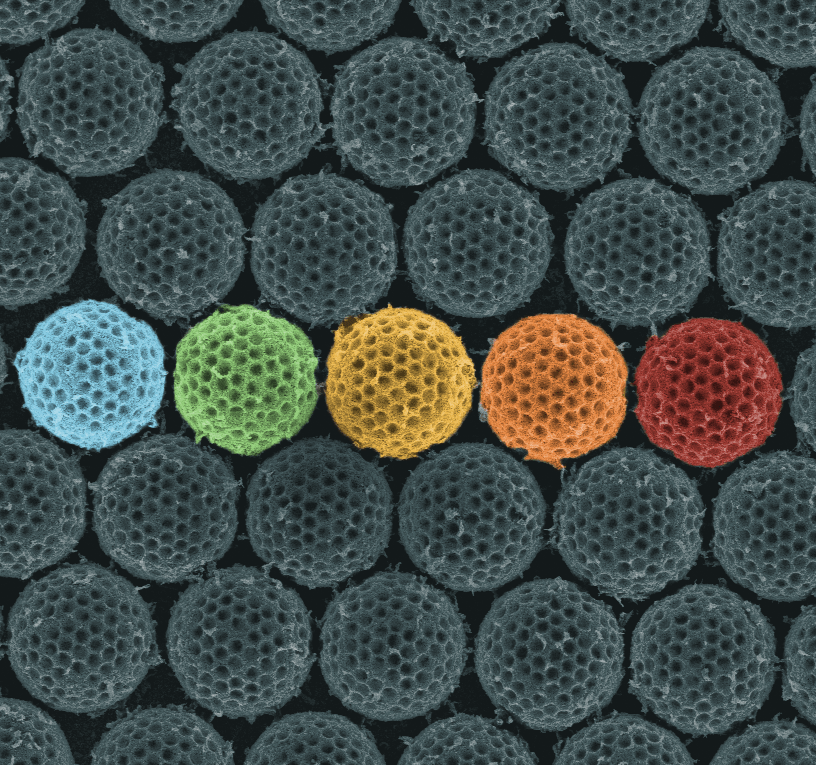Nov 6 2017
According to Penn State engineers, synthetic microspheres with nanoscale holes are capable of absorbing light from all directions across an extensive range of frequencies, allowing them to be considered for use in antireflective coatings.
The synthetic spheres also explain how the leaf hopper insect uses related particles to conceal themselves from predators in its environment.
 Synthetic brochosomes (false colored). Image: Shikuan Yang / Birgitt Boschitsch / Penn State
Synthetic brochosomes (false colored). Image: Shikuan Yang / Birgitt Boschitsch / Penn State
Researchers have long known that leaf hoppers extrude microparticles, known as brochosomes, and wipe them on their wings. Since the particles are superhydrophobic, the leaf hopper's wings remain dry in wet conditions. What was not understood before the present work is that the brochosomes also permit leaf hoppers and their eggs to merge with their backgrounds at the wavelengths of light visible to their primary predators, such as the ladybird beetle.
We knew our synthetic particles might be interesting optically because of their structure, we didn't know, until my former postdoc and lead author of the study Shikuan Yang brought it up in a group meeting, that the leaf hopper made these non-sticky coatings with a natural structure very similar to our synthetic ones. That led us to wonder how the leaf hopper used these particles in nature.
Tak-Sing Wong, assistant professor of mechanical engineering and the Wormely Family Early Career Professor in Engineering.
Upon searching for scientific literature regarding the leaf-hopper brochosomes' use as camouflage, nothingarose. However the pits' sizes in the synthetic microspheres are very near to the wavelength of light, and can trap up to 99% of light, ranging from UV through visible and into the near infrared. The particle surface behaves like a metamaterial, the type of material used in cloaking devices.
"The problem is that in the field, these leaf hoppers produce very little of this product, and it is very hard to collect," Wong said. "But we had already produced large quantities of these structures in the lab, enough to put inside a machine to look at their optical properties."
In a paper published online in the November 3 issue of the Nature Communications, the researchers replicated insect vision and found that the brochosomes are very possible camouflage coatings against leaf hopper predators. Camouflage is seen a lot in nature, however there are very few examples of natural antireflective coatings, moth eyes being a popular exception. Moth eyes are covered in anti-reflective nanostructures which help prevent light from reflecting off them at night when predators might easily spot them.
The synthetic microspheres are produced via a rather intricate five-step process using electrochemical deposition. However, the process can be expanded and many varieties of materials can be used to make the synthetic brochosomes, such as manganese oxide, gold, silver, or even a conductive polymer.
Different materials will have their own applications, for example, manganese oxide is a very popular material used in supercapacitors and batteries. Because of its high surface area, this particle could make a good battery electrode and allow a higher rate of chemical reaction to take place.
Tak-Sing Wong, assistant professor of mechanical engineering and the Wormely Family Early Career Professor in Engineering.
As an antireflective coating, this material could have applications in cameras and sensors, where capturing undesirable light reflection could raise the signal-to-noise ratio. This also could be predominantly useful in telescopes. For solar cell applications, a coating of synthetic brochosomes could boost light capture at numerous wavelengths and from every angle because of the 3D soccer-ball-shaped structure of the spheres, making it pointless to construct devices to track the sun.
"This paper is more of a fundamental study," Wong said. "In the future, we may try to extend the structure to longer wavelengths. If we made the structure a little larger, could it absorb longer electromagnetic waves such as mid-infrared and open up further applications in sensing and energy harvesting?"
That remains to be researched.
Lead author Shikuan Yang is presently a professor at Zhejiang University, China. Other authors on the paper, titled "Ultra-antireflective Synthetic Brochosomes," are graduate students Nan Sun, Birgitt Boschitsch Stogin and Jing Wang and postdoctoral scholar Yu Huang, all in the Department of Mechanical and Nuclear Engineering and the Materials Research Institute, Penn State.
This work was supported by the Defense Advanced Research Projects Agency and the National Science Foundation.